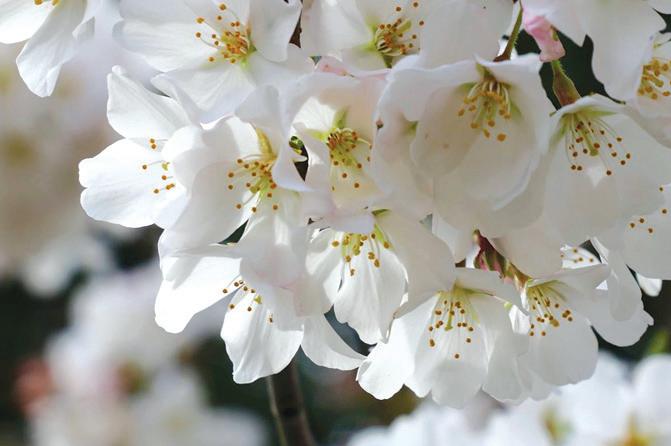
35 minute read
REAL ESTATE
Out of Many, One
A GEORGETOWN ROW HOUSE WITH A STORIED PAST COMES INTO ITS OWN. SUSAN BODIKER
The serene Federalist at 1431 33rd St NW is a jewel box of a house with an unusual pedigree. Built in the early 1820s, it was gifted to several generations of the original owner’s (somewhat litigious) family and eventually became a multiunit apartment building. Through the tasteful ministrations of Cecchi Homes and Boxwood Home Staging, it has been extensively renovated and restyled to a new level of glory.
The once-again single family home now offers 5148 square feet of living space on four levels and includes six bedrooms, each with an ensuite bath, one half bath, two gas fireplaces, flagstone rear patio and fauxboxwood covered garage, roof deck and an elevator with access on every floor. It is on the market for $5,450,000.
Builder John Cecchi had visited the house often and knew he could bring it back to its former beauty. On the main level, at the front, are the formal spaces--living room and dining room–which lead down a long gallery hall to a step-down kitchen and family room. The living room features a transitional grey marble fireplace and elegant cove and picture frame molding, which, like the decoratively patterned wide-plank wood flooring, runs throughout.
Working with Cecchi, stager Sammy van Blommestein selected a neutral color palette and furnishings with traditional but clean lines that “reflect the classic flavor of Georgetown” yet add a contemporary flair of their own.
In the kitchen, a very large (128”-wide) island occupies center stage and is topped with bookmatched Calacatta marble and waterfall edge. Extensive white paneled cabinetry are adorned with Restoration A statement tub and then some. A chrome clad tub sits in a fluted niche. Courtesy of HomeVisit.
Hardware knobs and textured pulls that gleam like jewels. (They also repel finger prints.) Chef’s grade appliances and finishes include Waterworks fixtures; SubZero French door refrigerator and wine cooler; ASKO dishwasher, and Wolf fourburner range, microwave and double oven. A variegated grey marble interlocking tile backsplash brings it all together.
The kitchen flows into the bright and airy family room accented by wide shiplappaneled walls (so not “Fixer Upper”), corner windows and French doors that open onto the rear patio.
Upstairs, on the second level, there are two large bedrooms with walk-in closets and marble and glass baths. The master suite boasts two enormous walk-in closets fitted with custom shelving and a grand master bathroom with a chrome-clad double-slipper soaking tub, frameless glass steam shower with multiple shower heads and two separate marble-topped vanities. One floor above, there are two more bedrooms (one with a marble fireplace that could serve as a library or office), marble baths and wet bar fitted with an L-shaped
Entry hall-Taking the long view. From the entry way, you can see all the way back to the rear garden. Courtesy of HomeVisit.

marble counter, ice maker and wine fridge. French doors reveal a spacious eastfacing roof deck with views overlooking northwest Washington.
The fully finished lower level features herringbone tiled floors, a large rec room, bedroom with marble bath, extra storage and laundry room with stacked Electrolux washer and dryer and paneled cabinets.

Offered at $5,450,000, the newly restored six-bedroom, six-and-a-half bath home at 1431 33rd St NW is listed with Washington Fine Properties. For details, contact Nancy Taylor Bubes, 202-386-7813 or nancy.taylorbubes@wfp.com. For a visual tour, visit http://spws.homevisit. com/hvid/274936.
Photo credits: HomeVisit
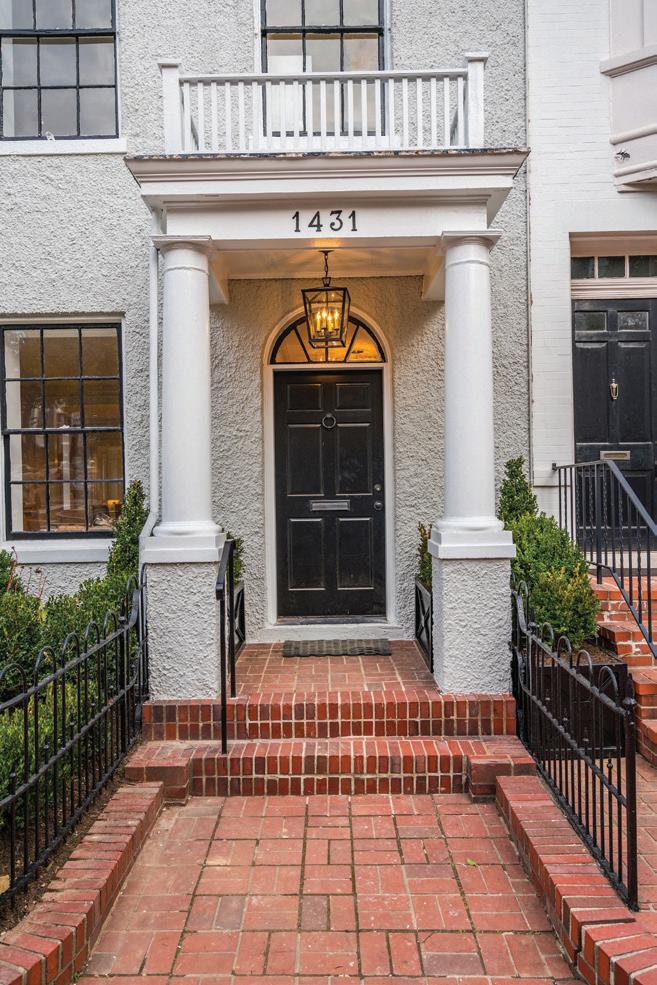

Remember Us
GU272 MEMORY PROJECTS — GEORGETOWN UNIVERSITY CONFRONTS ITS LEGACY OF SLAVERY BY ROBERT DEVANEY
“The affair gave many here a reason for speaking badly about us. No one does this but bad people, as they are dealers of Negroes, who care for nothing except money ... the slaves who were under my care conducted themselves well ... if they did need to be sold, they could have been sold without scandal and clear danger of losing their souls.”
Dr. Linda Mann interviewing a GU272 descendant. Photo by Claire Vail. Courtesy AA-NEHGS.
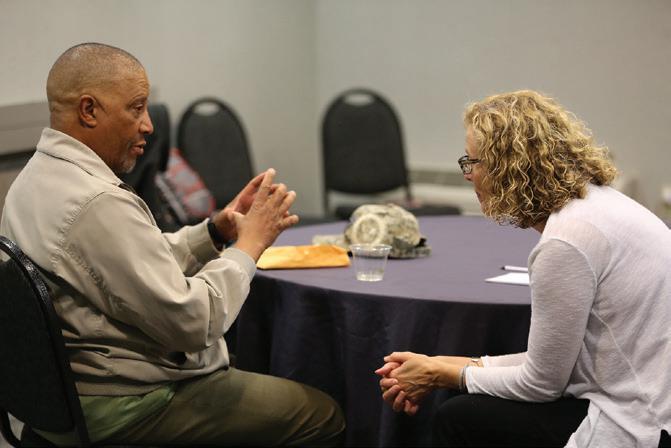
So wrote Dutch Jesuit Peter Havermans grimly in October 1838 of the sale of more than 272 enslaved persons from Maryland plantations, owned by the Society of Jesus, due to mounting debts that included small Georgetown College in Washington, D.C. Those 272 — from infants to the elderly — departed on a ship from Alexandria to New Orleans, where they would work sugarcane fields and endure cruel conditions. Lost (almost) to history were the souls that feared for their lives and their Catholic faith.
AN AWAKENING
In the 21st century, an awakening dawned at Georgetown University, after similar acknowledgments by Brown, Columbia, Harvard and the University of Virginia, that administrators had bought and sold slaves. Georgetown’s slaveholding reckoning would be different, because its sale involved such a large number of people — and because the documentation, both available and to be tracked down, was more than ample.
In 2014, Georgetown student Matthew Quallen wrote an account of the Jesuits’ 1838 sale in the Hoya student newspaper. He urged the university to strip the names of Georgetown Jesuits Thomas Mulledy and William McSherry from buildings named for them because of their involvement in the sale. (It should be noted that university records and history books told of the slavery story.)
In the months that followed, which saw student protests, Georgetown professor Adam Rothman, a member of Georgetown University’s Working Group on Slavery, Memory & Reconciliation, summed up the process then beginning: “It seems to me that the story of Georgetown and slavery is a microcosm of the whole history of slavery.” The university renamed those two buildings for Isaac Hawkins, the first slave listed in the ship’s manifest, and to Anne Marie Becraft, the founder of a school for black girls in Washington, D.C.
ATONEMENT — AND REPARATIONS?
The university and the Society of Jesus formally apologized for their involvement in slavery and for the sale that shattered families and sold them down the river. It was an emotional day for many when hundreds of descendants gathered for the apology at Antoinette Beshears Baines. Photo by Claire Vail. Courtesy AA-NEHGS.
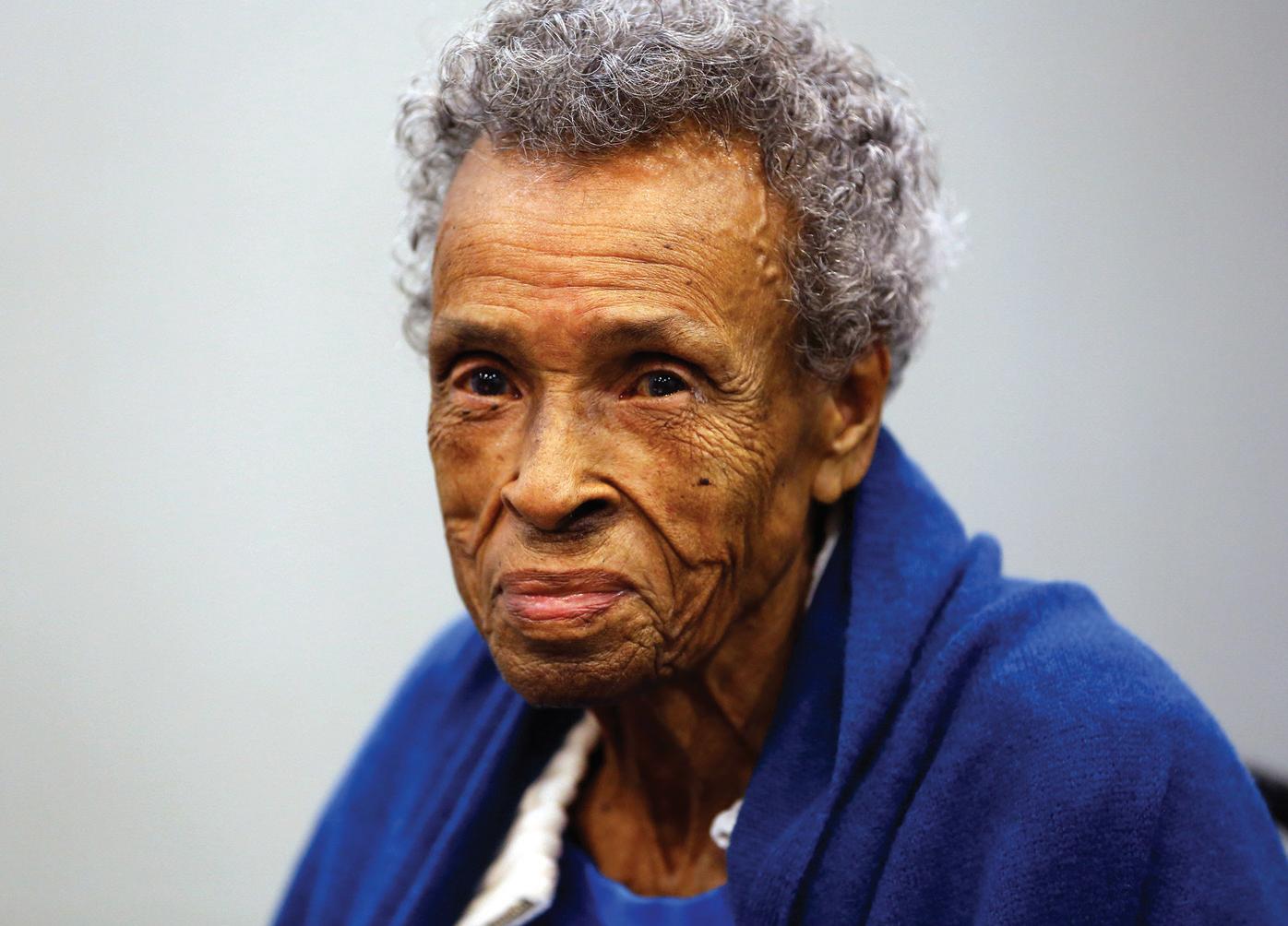
Gaston Hall and later planted a tree in the Quad, adding soil from Louisiana.
The university announced a legacy designation of admission for descendants of those enslaved and sold, similar to the extra attention given to children of GU alumni, teachers and others. Most recently, an annual fund of $400,000 to support projects and groups in the descendant community was initiated.
In contrast, the Georgetown University Student Association and the GU272 Advocacy Team put together a plan for reparative action. The referendum they proposed called for a fee of $27.20 to be added to each student’s yearly tuition for the benefit of the descendants. Last spring, students voted to approve the referendum. It was the first proposal of its kind in the United States, displaying support for the continuation of reparations. (Separately, some descendants have called for a $1-billion reparations fund.)
“This is not a disembodied group of people, who are nameless and faceless. These are real people with real names and real descendants.” — Richard Cellini, Georgetown Alumnus
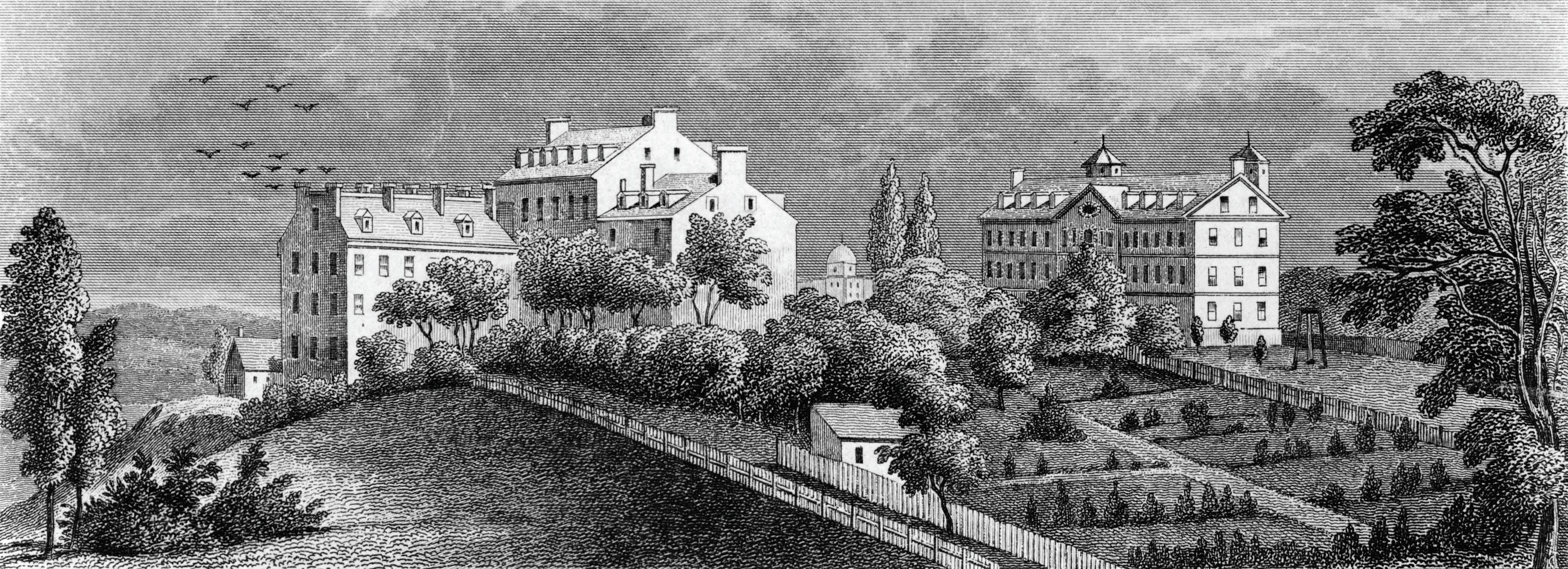
First page of the GU272 Bill of Sale, dated June 19, 1838. Courtesy AA-NEHGS.
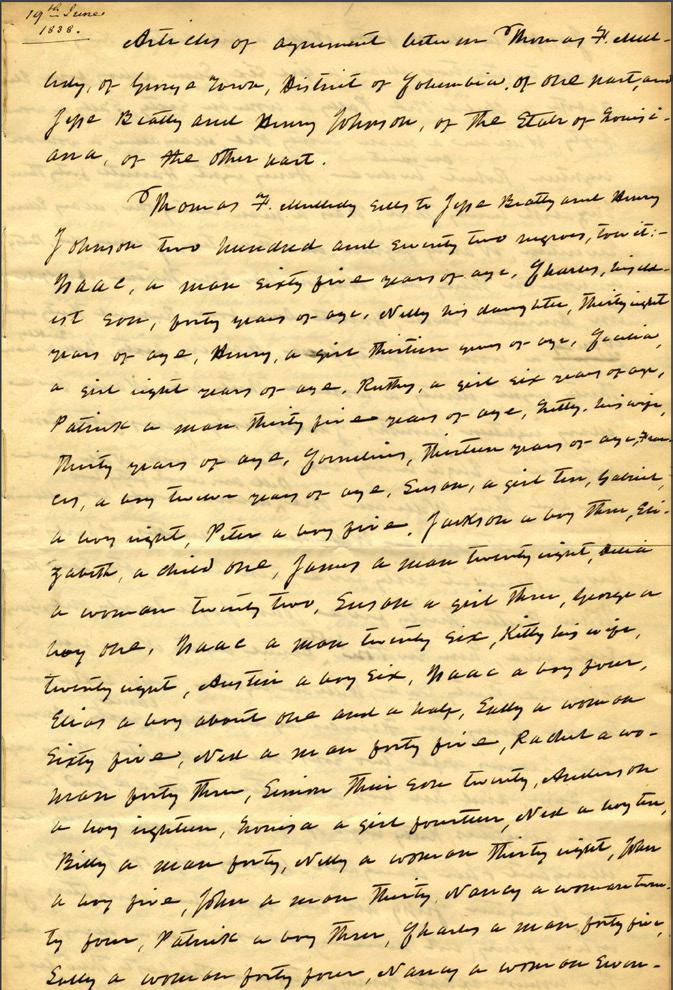
Avoiding the word “reparations,” Georgetown University President John J. DeGioia has said: “We embrace the spirit of this student proposal and will work with our Georgetown community to create an initiative that will support community-based projects with Descendant communities … The University will ensure that the initiative has resources commensurate with, or exceeding, the amount that would have been raised annually through the student fee proposed in the Referendum, with opportunities for every member of our community to contribute.”
FINDING THE ANCESTORS
Still, the sorrowful question persists: Who were these good, Catholic people that were betrayed and cast off? And where did their descendants live on and prosper? “What we so often lack is the perspective of enslaved people themselves,” Rothman has noted.
As it turns out, Georgetown has an array of genealogical tools to offer those looking to trace connections between past and present.
“A great deal of the credit for discovering the descendants goes to Patricia BayonneJohnson, a descendant of Nace and Biby Butler, a husband and wife who were sold by Thomas Mulledy to Jesse Batey in 1838 and transported to Louisiana,” according to Georgetown University. “Bayonne-Johnson … discovered her connection to Nace and Biby Butler while researching her family tree in 2004. Using documents from the Jesuit Plantation Project, and with help from Louisiana genealogist Judy Riffel, Bayonne-Johnson learned of the story of the 1838 sale and uncovered additional documents, including the manifest of the Katherine Jackson.
“After Georgetown president Jack DeGioia formed the Working Group for Slavery, Memory, and Reconciliation at Georgetown University, we created the Georgetown Slavery Archive to replace the defunct Jesuit Plantation Project website and publish additional documents from Georgetown’s archives relating to the university’s relationship to slavery and slaveholding in the Maryland Province, and to the fate of the people who were sold to Henry Johnson and Jesse Batey in 1838.”
Soon enough, Georgetown alumnus Richard Cellini took on the task of researching the GU272 descendant community with his independent Georgetown Memory Project, aided by contributions from fellow alums. “This is not a disembodied group of people, who are nameless and faceless,” Cellini told the New York Times, which published major stories on the Jesuits’ slave sale four years ago. “These are real people with real names and real descendants.” As of this month, Cellini lists persons identified and located: 227 ancestors; 9,269 direct descendants.
Another website was created last year to assist the search. “The GU272 Memory Project marks the first time that genealogical data about the GU272 will be publicly available. It’s a milestone in online resources for African American family history,” said Claire Vail, director of creative and digital strategy, American Ancestors & New England Historic Genealogical Society.
“The GU272 Memory Project was a natural fit for us,” said Vail, who added that they “traveled to Louisiana to capture oral histories from the largest group of descendants. We spoke with at least
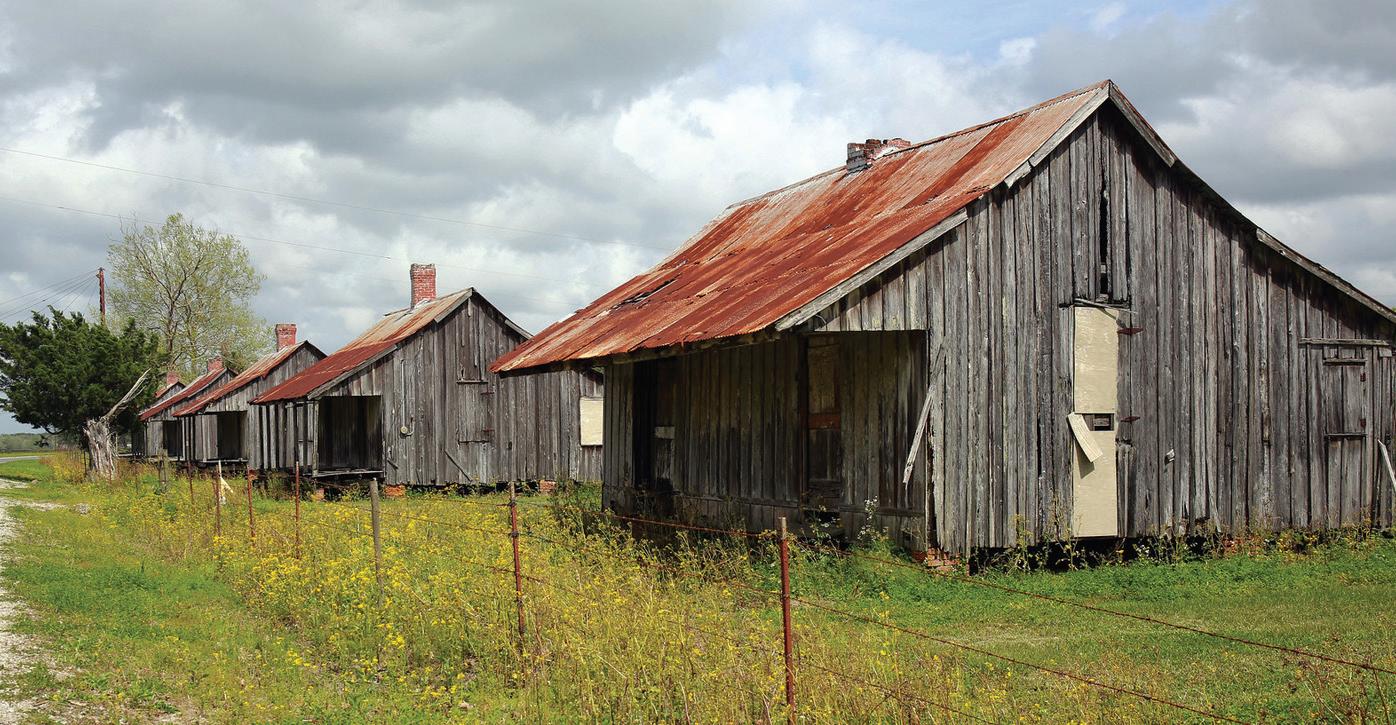
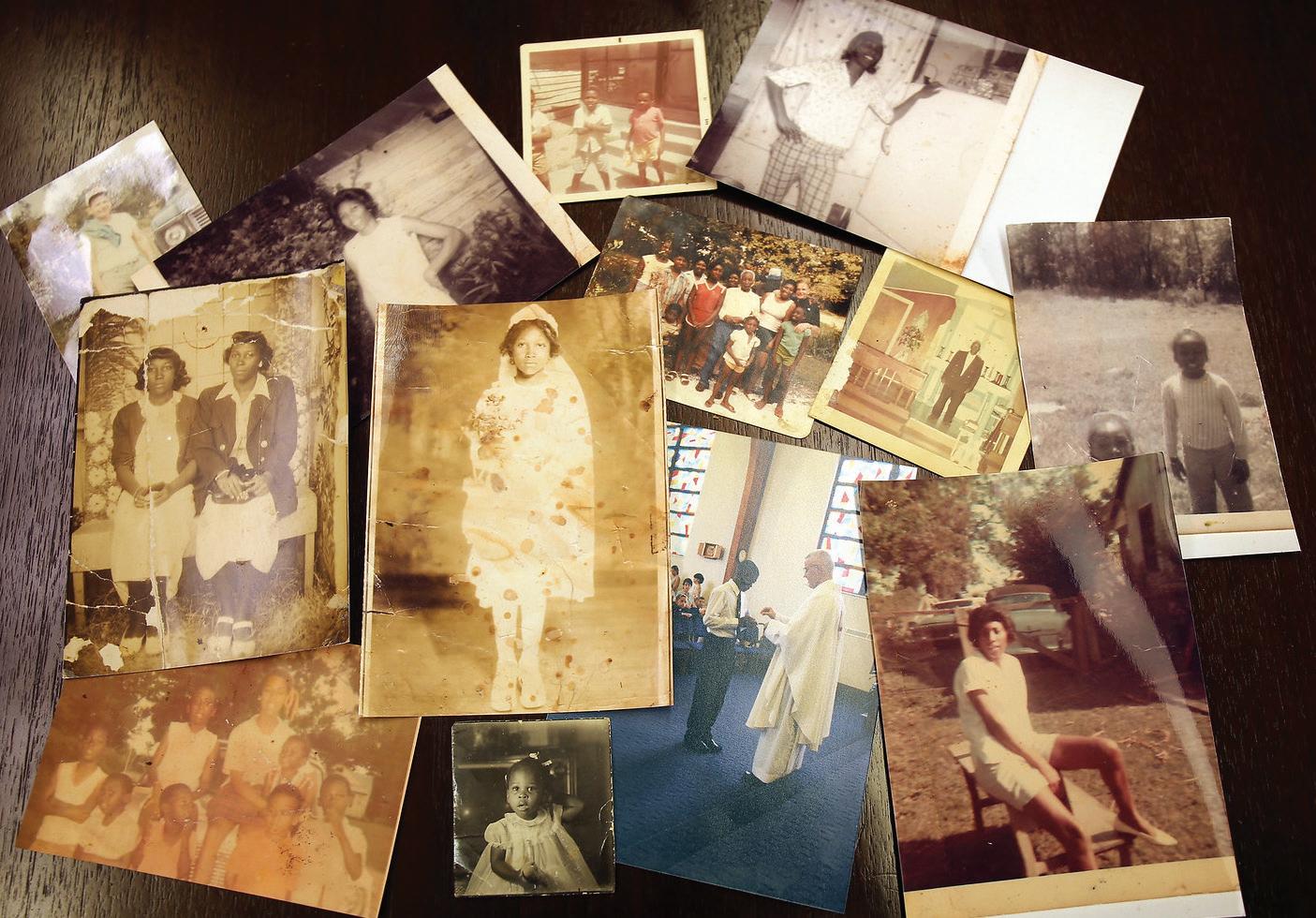
Photos of GU272 descendent Donna Comeaux’s family. Photo by Claire Vail. Courtesy AA-NEHGS.
“We spoke with at least 30 descendants living in Baton Rouge, Houma and New Orleans, for a total of 50 interviews to date across many families.” — Claire Vail, American Ancestors & New England Historic Genealogical Society
30 descendants living in Baton Rouge, Houma and New Orleans, for a total of 50 interviews to date across many families.” Vail commented that finding and digitizing the available documents — “and making it searchable and making it public — is a vitally important task, both for descendants and for historians. Identifying enslaved people is a vital step in gaining a better understanding of America — past and present.”
Four years ago, Cellini phoned Maxine Crump in Baton Rouge with the revelation that her great-great-grandfather Cornelius Hawkins was one of those slaves sold by the Jesuits to the Louisiana plantation. “Oh my God,” she cried. “Oh my God.” That was Neely, buried in the only Catholic cemetery in the area. “Now they are real to me,” Crump told the Times. “More real every day.”
DESCENDANTS BECOME HOYAS
Among the first descendants to matriculate at Georgetown are Elizabeth Thomas and Shepard Thomas, the children of Sandra Green Thomas, great-greatgranddaughter of Sam Harris and Betsy Ware Harris.
“In the mid-1990s, I lived within walking distance of Georgetown. I was pushing my babies around in a stroller, going on campus, without knowing anything about the connection,” Thomas recalled in a Times piece. “I read The New York Times, and I saw the story there. I saw the photo of the cemetery, and I saw Maringouin, La. I went to the website of Georgetown’s slavery archive and saw the names of my relatives … I find it somewhat comforting and amazing that the immediate family remained intact after being sold … When I first read it, I was just looking at the facts. But when you start thinking about it, it is really horrific.”
As if to complete a particular circle of life, Georgetown graduate Elizabeth Thomas is now an ABC News reporter. Last year, she and another descendant student, Melisande Short-Colomb, went to the Jesuit cemetery on the university’s main campus. In front of the tombstone of Thomas Mulledy, S.J., who coordinated the slave sale, they told him: “Look at us now.”
No doubt, there will be more arguments about reparative action by the school and more programs and memorials to follow.
Meanwhile, this sinful chapter of Georgetown University and of America is leading to something of a miracle: those once lost to history and are now among us — and remembered.
TO LEARN MORE, VISIT: slaveryarchive.georgetown.edu/ descendants
georgetownmemoryproject.org

NATIONAL GEOGRAPHIC’S
BY RICHARD SELDEN
Jane Goodall is 85. When she showed up at Tanganyika’s Gombe Stream Game Reserve in the summer of 1960 — with her mother as chaperone and a cook named Dominic — she was 26.
As many of us learned as animalloving youngsters, Goodall had gone to Tanganyika (now Tanzania) to observe chimpanzees in the wild. What came to be a 60-year calling began with a suggestion from paleoanthropologist Louis Leakey, who, with his colleague and wife Mary, was finding and studying fossils of human ancestors. Goodall had sought out Leakey, the son of missionaries in British East Africa, three years earlier.
“Becoming Jane,” an immersive exhibition about Goodall’s remarkable life and career — created in partnership with the Jane Goodall Institute, a conservation organization based in Vienna, Virginia — opened last November at the National Geographic Museum. It will remain on view through the summer, then travel to the Natural History Museum of Los Angeles County and other venues.
In addition, the famed primatologist, since 2004 a Dame Commander of the Most Excellent Order of the British Empire, will be celebrated in D.C. this spring with a series of public events.
On March 13, filmmaker Bill Wallauer, the Jane Goodall Institute’s scientific advisor, will lead a virtual-reality journey through the forests of Gombe (National Geographic boasts the world’s largest VR theater).
This year’s Environmental Film Festival in the Nation’s Capital will conclude on March 21 with a world-premiere screening of “Jane Goodall: The Hope.” And on March 23, Sara Manco and Karen Cerka, National Geographic’s photo archivist and film archivist, will conduct a Goodallthemed “Into the Archive” program.
The March events will all take place at National Geographic headquarters, as will a one-day Jane Goodall Film Festival, running from 11 a.m. to 8:30 p.m. on May 9. Goodall herself will make an appearance on April 6, three days after her 86th birthday, at DAR Constitution Hall.
“We’ve been telling her story since 1960,” noted Kathryn Keane, executive director of the National Geographic Museum and vice president of public experiences at the National Geographic Society.
Keane called Goodall “gracious” during the planning process for the exhibition — which required a lot of custom voiceover work — but “also very outspoken and firm about things that she wanted.”
Visitors to the exhibition get a taste of multimedia right at the start, when blowups of three National Geographic Magazine covers switch to video. The star of the show greets them (“Hello, I’m Jane Goodall”), then a chimp escapes from the famed yellow frames.
“Becoming Jane” offers “a lot of things to see and do and play with,” said Shawn Sweeney, the Jane Goodall Institute’s senior director of community engagement. That’s an understatement. At “Chimp Chat” booths, for example, one can practice speaking chimp. At an “Observation Station,” augmented-reality characters
BECOMING JANE
appear in binoculars, along with a narration. But this visually appealing show strikes a balance between stations that make use of interactive and immersive technologies and traditional displays of one-of-a-kind artifacts. To name two of the latter: Jubilee, Goodall’s stuffed chimp from childhood, named for the baby born in 1935 (the year of George V’s jubilee) to Boo Boo, a chimp at the London Zoo; and a four-page letter home written by the 22-year-old Goodall while on a three-week ocean voyage to Mombasa on the Kenya Castle.
A bit farther along, visitors are welcomed to Chimpland — Goodall’s name for her Gombe camp — by a hologram of the young researcher. Later, theater doors open and one dons glasses for a stunning 360-degree experience, during which Goodall describes the moment when chimps she named Goliath and David Greybeard preened near her for the first time, unafraid: “Without any doubt, this was my proudest moment.” Goodall enrolled at the University of Cambridge from 1962 to 1965, earning a Ph.D. in ethology, the study of animal behavior. The paradigm-changing, fiercely challenged observation in her thesis, “Behaviour of Free-Living Chimpanzees,” was of chimps making and using tools. Man (that is, humans) could no longer be uniquely characterized as “the Toolmaker.” Early film footage of Goodall interacting with chimps — a practice that is no longer sanctioned — was shot by Hugo van Lawick, a photographer and filmmaker born in Indonesia to Dutch parents. Also directed to Gombe by Leakey, van Lawick married Goodall in 1964 and they had a son, Hugo Eric Louis, known as Grub, three years later (the couple divorced in 1974 and van Lawick died in 2002). Goodall has two grandsons, Merlin and Nick, and a granddaughter, Angel.
What is referred to as Goodall’s “Damascus Moment” came in 1986, when she published “The Chimpanzees of Gombe: Patterns of Behaviour” and spoke at a conference in Chicago. Just as she then adopted a more holistic approach, focusing on the protection of animals through environmental conservation and sustainable human practices, the exhibition shifts in midstream to a wider lens.
Four threats — habitat loss, disease, trafficking and hunting — are flagged, and ways to combat them identified. Background is provided on the Jane Goodall Institute’s Roots & Shoots program, which works to motivate youth throughout the U.S. and in some 50 countries, and its communitycentered Tacare approach.
Finally, at Trees of Hope kiosks, visitors pledge to make a change in their routines: Use Less Plastic, Avoid Palm Oil, Take A Walk.
Compared with Goodall’s lifetime of devotion, it seems a small thing to ask.
BECOMING JANE NATIONAL GEOGRAPHIC MUSEUM 1145 17TH ST. NW OPEN DAILY, 10 A.M. TO 6 P.M. ADMISSION: $15
BY ARI POST
“The Curtain,” c. 1880. Edgar Degas. Courtesy National Gallery of Art.
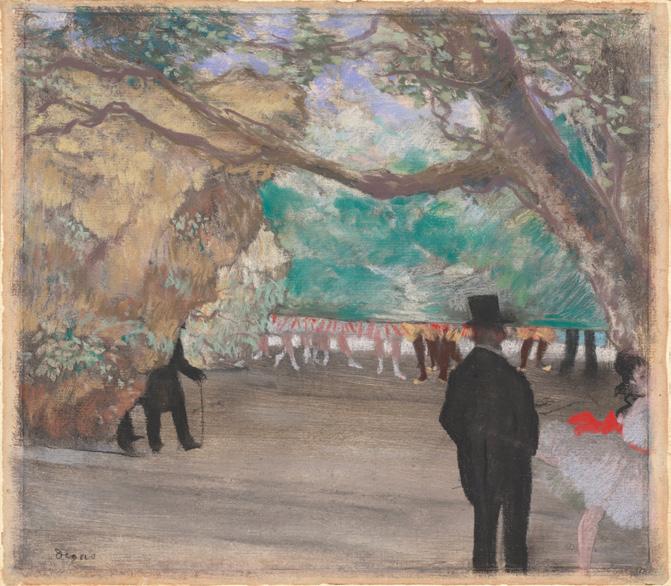
DEGAS AT THE OPÉRA NATIONAL GALLERY OF ART March 1 to July 5
Edgar Degas (1834–1917) is the premier painter of dancers, a subject that dominated his art for nearly four decades. His renowned images of the Paris Opéra are among the most sophisticated and visually compelling works he created. Celebrating the 350th anniversary of the Paris Opéra’s founding, this exhibition will present 100 of the artist’s best-known and beloved paintings, pastels, drawings, prints and sculptures.
Degas explored both the public spaces of the Opéra — auditorium, stage and boxes — and more private ones, including dance studios and backstage. He was friends with many of the people he depicted in his paintings, from dancers, singers and orchestra musicians to the formally dressed subscribers. The Opéra also fueled some of Degas’s most daring technical innovations, including his first monotype and his iconic wax sculpture “Little Dancer Aged Fourteen,” which revolutionized the medium.
“Infinity Mirror Room — Phalli’s Field,” (1965). Yayoi Kusama. Courtesy Hirshhorn.

ONE WITH ETERNITY: YAYOI KUSAMA IN THE HIRSHHORN COLLECTION HIRSHHORN MUSEUM April 4 to Sept. 20
“One with Eternity: Yayoi Kusama in the Hirshhorn Collection” is a tribute to the life and practice of Yayoi Kusama (b. 1929), a visionary artist whose revelatory practice has captivated audiences around the world. Building on the Hirshhorn’s blockbuster 2017 show “Yayoi Kusama: Infinity Mirrors,” this new exhibition will affirm Kusama’s legacy within the museum’s collection and art history with three significant new acquisitions.
“One with Eternity” will showcase the Hirshhorn’s permanent collection of works by Kusama — including two of her “Infinity Mirror Rooms,” her first and one of her most recent — while honoring her distinctive vision by exploring its development across multiple media. Note: Free same-day timed passes will be distributed daily at the museum starting at 9 a.m.
A projection in the “Age Old Cities” exhibition. Courtesy NMAA.

AGE OLD CITIES: A VIRTUAL JOURNEY FROM PALMYRA TO MOSUL NATIONAL MUSEUM OF ASIAN ART (FREER AND SACKLER GALLERIES) Through Oct. 25
In the recent past, Iraq and Syria have suffered profound upheavals that have destroyed many significant cultural and religious sites, leaving little of the rich historical past. Using groundbreaking digital installations, “Age Old Cities” takes visitors on a virtual tour of three ancient cities: Palmyra and Aleppo in Syria and Mosul in Iraq.
Organized by the Arab World Institute in Paris, “Age Old Cities” was created in collaboration with Iconem, which specializes in digitizing cultural heritage sites in 3D, and in partnership with UNESCO.
The exhibition offers an immersive experience, inviting visitors into the heart of each of the three cities with large-scale projections of dynamic imagery and 3D reconstructions of damaged monuments. The projections shift gradually from destruction to progressive reconstruction. In this way, the exhibition highlights the devastation of these sites — all cornerstones of world culture — but also offers hope for their reconstruction and rehabilitation.
Several videos feature interviews not only with archaeologists and curators, who work at great personal risk to protect and preserve these sites, but with residents. Others explore unique parts of the cities, such as the markets of Aleppo or the Tomb of the Three Brothers in Palmyra, an underground burial chamber turned into an ISIS base of operations. “1.8 Renwick,” 2015. Janet Echelman. Courtesy SAAM.

JANET ECHELMAN’S 1.8 RENWICK RENWICK GALLERY, SMITHSONIAN AMERICAN ART MUSEUM Opens April 3
This colorful fiber and lighting installation by Janet Echelman (b. 1966) examines the complex interconnections between human beings and our physical world, also revealing the artist’s fascination with the measurement of time. The work, a volumetric form suspended from the ceiling, was inspired by the data recorded following the Tohoku earthquake and tsunami that rippled across the Pacific Ocean toward Japan on March 11, 2011. This geologic event was so powerful that it shifted the earth on its axis and shortened the day by 1.8 millionths of a second, lending the work its title.
Echelman’s knotted meditation contrasts the forces we can understand and control with those we cannot, while setting the concerns of our daily existence against the larger cycles of time. Shifting light will cast projected shadow drawings in vivid colors that will move from wall to wall, enticing viewers to lie down on the carpet and contemplate the work.
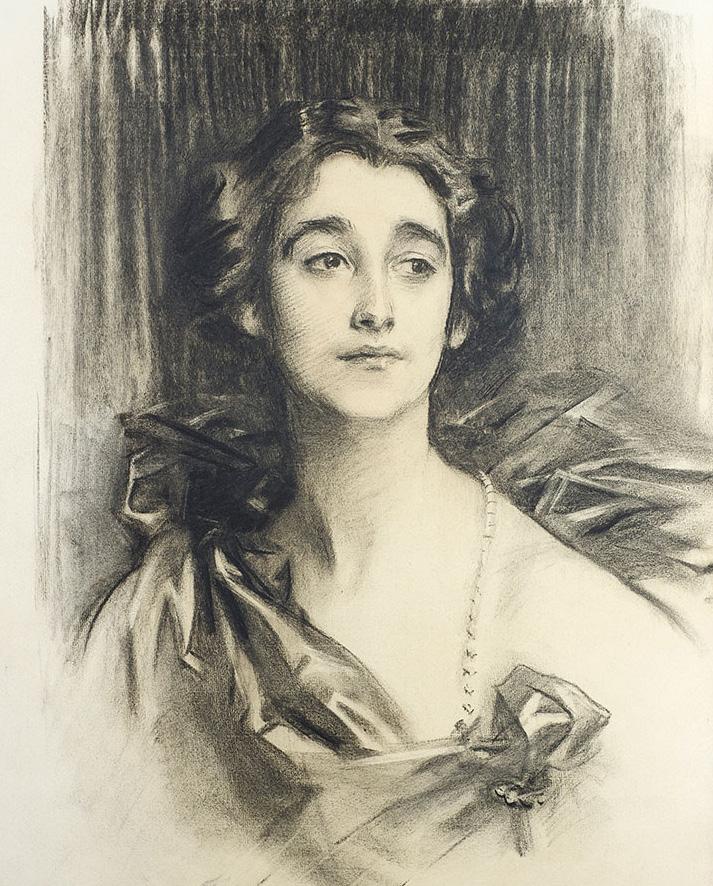
JOHN SINGER SARGENT: PORTRAITS IN CHARCOAL NATIONAL PORTRAIT GALLERY Feb. 28 to May 31
In 1907, at the height of his success as a portraitist, John Singer Sargent (1856–1925) astonished the transatlantic art world when he stopped painting portraits in oil. Switching to charcoal, Sargent produced several hundred portraits of individuals recognized for their accomplishments in fields such as art, music, literature and theater.
Organized by the National Portrait Gallery and the Morgan Library & Museum in New York, “John Singer Sargent: Portraits in Charcoal” will be the first exhibition of Sargent’s portrait drawings in over 50 years. This once-in-a-lifetime assemblage of master drawings will feature compelling depictions of an international network of the Gilded Age elite.
Untitled, Mexico City, 1969–72. Graciela Iturbide. Courtesy NMWA.
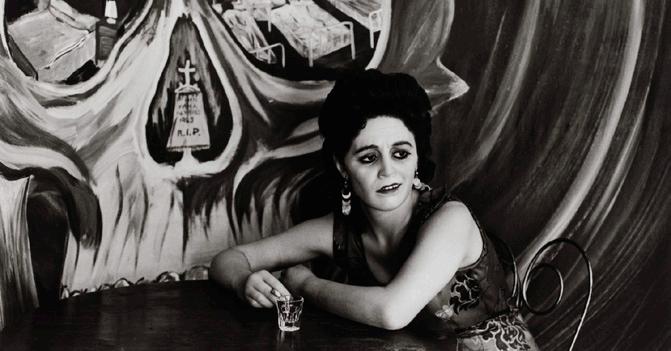
GRACIELA ITURBIDE’S MEXICO NATIONAL MUSEUM OF WOMEN IN THE ARTS Feb. 28 to May 25
For the past 50 years, Graciela Iturbide (b. 1942) has produced majestic, powerful and sometimes visceral images of her native Mexico. One of the most influential contemporary photographers of Latin America, Iturbide transforms ordinary observation into personal and lyrical art. Her signature black-and-white gelatin silver prints present nuanced insights into the communities she photographs, revealing her own journey to understand her homeland and the world.
“Graciela Iturbide’s Mexico” is the artist’s most extensive U.S. exhibition in more than two decades, comprising 140 photographs organized around nine themes. Her photographs that document the Seri, Juchitán and Mixtec societies offer compelling insight into the daily lives and customs of indigenous men and women. Iturbide demonstrates her deep awareness of complex cultural symbols through representations of processions honoring the dead, as well as lavish, exuberant fiestas that highlight Mexico’s pre-Hispanic and Spanish heritages. Her depictions of animals, birds and plants are rendered with as much sensitivity as her images of people, calling attention to the relationship between human presence and nature.
The exhibition will also feature Iturbide’s haunting snapshots of personal items that painter Frida Kahlo left at her home, la Casa Azul (the Blue House), after Kahlo’s death. These photographs connect Iturbide to Kahlo, another of Mexico’s most celebrated artists, as two women who have used their craft to grapple with and transcend the hardships and tragedies of life.
RIFFS AND RELATIONS: AFRICAN AMERICAN ARTISTS AND THE EUROPEAN MODERNIST TRADITION THE PHILLIPS COLLECTION Feb. 29 to May 24
“Riffs and Relations: African American Artists and the European Modernist Tradition” will present works by African American artists of the 20th and 21st centuries together with examples by the early 20th-century European artists with whom they engaged. The exhibition will explore the connections and frictions around modernism in the work of artists such as Romare Bearden, Robert Colescott, Renee Cox, Wassily Kandinsky, Henri Matisse, Pablo Picasso, Hank Willis Thomas and Carrie Mae Weems.
European modernist art has been a complicated influence on black artists for more than a century. The powerful pushand-pull of this relationship constitutes a distinct tradition for many African American artists, who have mined the narratives of art history, whether to find inspiration, mount a critique or claim their own space. “Riffs and Relations” will examine these cross-cultural conversations and present the divergent works that reflect these complex dialogues. “And She was Born,” 2017. Janet Taylor Pickett. Courtesy Phillips Collection.

PERFORMANCE
BY GARY TISCHLER AND RICHARD SELDEN
THEATER
If you want to know what’s up at the Shakespeare Theatre Company under new Artistic Director Simon Godwin, you can get a fair idea with two current productions: “The Amen Corner,” a rousing gospel play by James Baldwin, directed by Whitney White, at Sidney Harman Hall (through “The Amen Corner.” Courtesy STC.
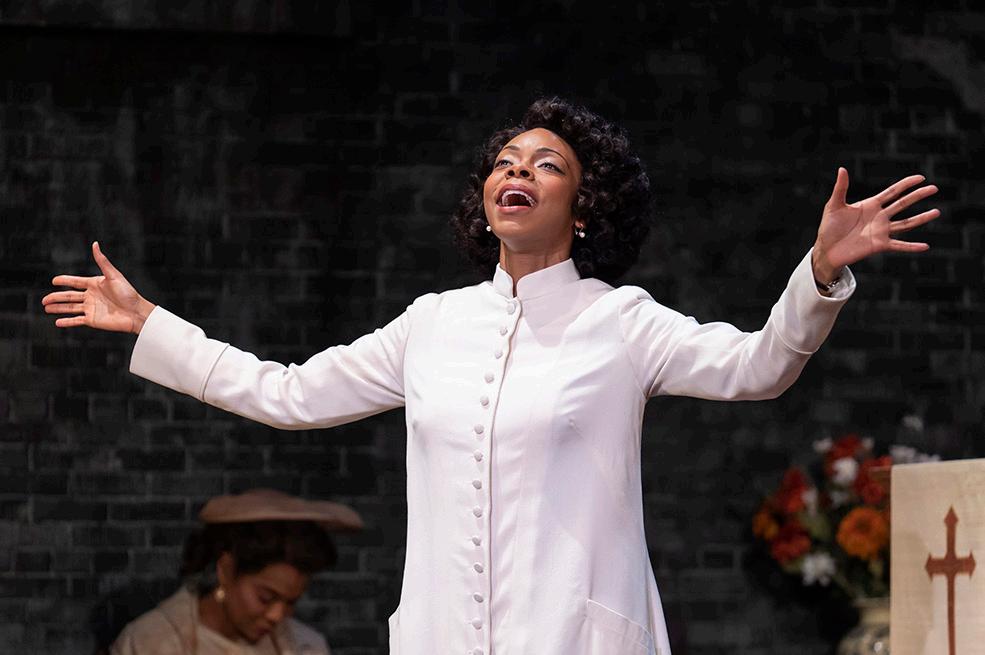
March 15); and Godwin’s directorial debut, the rarely performed Shakespeare tragedy “Timon of Athens,” at the Michael R. Klein Theatre, formerly the Lansburgh (through March 22). Chocolate-infused musical comedy “Romantics Anonymous,” written and directed by Emma Rice, with music by Michael Kooman and lyrics by Christopher Dimond, will follow at the Michael R. Klein (April 7 to May 17).
Speaking of Shakespeare, Folger Theatre’s production of “The Merry Wives of Windsor,” director by Aaron Posner, is the last “at-home” production before the Folger Shakespeare Library closes for a major renovation (through March 1).
The August Wilson Festival winds up at Arena Stage with “Seven Guitars,” one of the finest plays in Wilson’s Century Cycle of 10 — one per decade, this one about the 1940s — depicting African American life in a corner of Pittsburgh (April 3 to May 3). In a somewhat similar but later vein: Antoinette Nwandu’s “Pass Over,” directed by Psalmayene 24, at Studio Theatre (March 4 to April 12). At Woolly Mammoth, “There’s Always the Hudson” by Paola Lázaro, directed by Jess McLeod, concerns a sexual abuse support group (April 6 to May 3).
“The Wanderers” by Anna Ziegler, directed by Amber McGinnis at Theater J, is about an arranged marriage in the Satmar Hasidic community (through March 15). Then Mark St. Germain’s “Becoming Dr. Ruth,” as in Westheimer, is due to return (March 27 to April 19).
Round House Theatre, in its renovated Bethesda home, will present “Cost of Living,” directed by Artistic Director Ryan Rilette, in which Pulitzer Prize-winning playwright Martyna Majok interweaves two narratives of disability (April 1 to 19). Coming up at GALA Hispanic Theatre: José Zayas directs “Tía Julia y el Escribidor (Aunt Julia and the Scriptwriter),” by Caridad Svich, based on a novel by Mario Vargas Llosa set in the Peru of the 1950s (April 23 to May 17).
“Inherit the Windbag,” a Mosaic Theater Company production directed by Lee Mikeska Gardner at the Atlas Performing Arts Center, centers on a volatile political debate in 1968 between the liberal, tart, acidic Gore Vidal and the conservative, tart, acidic William F. Buckley. Washington familiars John Lescault and Paul Morella star as Buckley and Vidal, respectively, in this world premiere by Washington Post

THREE WEEKS ONLY! MARCH 11 - MARCH 29 ORDER TODAY!

(202) 399-7993 MOSAICTHEATER.ORG Atlas Performing Arts Center valet Parking available
humor-and-politics columnist Alexandra Petri (March 11 to 29).
Tennessee Williams is back. Avant Bard has mounted “Suddenly Last Summer,” directed by Christopher Henley, at the Gunston Arts Center. The film version is still remembered for Elizabeth Taylor in a white bathing suit (through April 5). Ford’s Theatre is bringing us Frank Loesser’s “Guys and Dolls” with Bueka Uwemedimo as Sky Masterson (March 13 to May 20). More musicals: Rice and Lloyd Webber’s “Jesus Christ Superstar” in the Kennedy Center Opera House (April 14 to 26) and the Tony Award-winning musical “Bandstand,” from “Hamilton” choreographer Andy Blankenbuehler, about the return of American soldiers from World War II, at the National Theatre (March 3 to 8). Later on, the National will have a fling with Sting (yes, that Sting), as playwright and director of “The Last Ship” (March 27 to April 5).
OPERA
Bass-baritone Ryan McKinny will portray the libidinous antihero in Washington National Opera’s production of “Don Giovanni,” one of Mozart’s most ambitious, defiant and powerful works, with a libretto by Lorenzo Da Ponte, conducted by Evan Rogister in the Kennedy Center Opera House (Feb. 29 to March 22). Also in the Opera House: Saint-Saëns’s “Samson and Delilah,” with rising star J’Nai Bridges as Delilah and Roberto Aronica as Samson (March 1 to 21). In the second half of March, in the Eisenhower Theater, Kenneth Kellogg will star in “Blue,” a tale of a black Harlem police officer whose son is killed by a white police officer, with music by Jeanine Tesori and a libretto by Tazewell Thompson (March 15 to 28).
Washington Concert Opera’s spring production, conducted by Artistic Director Antony Walker in George Washington University’s Lisner Auditorium, is “Simon Boccanegra,” Verdi’s political-historical opera about a doge (chief magistrate) in 14th-century Genoa. The singers are baritone Lester Lynch in the title role, soprano Marina Costa-Jackson, tenor Kang Wang, baritone Musa Ngqungwana and bass Andrea Silvestrelli (April 25). The In Series brings us something traditional — Verdi’s “Rigoletto” — in a totally new and different way, decked out in an immersive circus production at the Atlas Performing Arts Center. Victoria Gau of Capital City Symphony will conduct (April 11 to 19).
JAZZ, POP, ROCK AND HIP HOP
Blues Alley will present some of the best guitarists in jazz this spring: Kevin Eubanks (March 19 to 22), Lee Ritenour (April 2 to 5) and John Pizzarelli (April 30 Kevin Eubanks.

to May 3). With the Embassy of Italy, the famed Georgetown club will also host an Italian Jazz Series (April 20 to 24).
Returning in June, as always, all over town: DC JazzFest (June 12 to 20). Spring highlights at Wolf Trap: Ladysmith Black Mambazo (March 16 and 17), the Fifth Dimension (March 20), Joan Osborne (April 16 and 17) and Jim Messina (April 21 and 22). The Birchmere keeps making it hard to choose, with acts like The Oak Ridge Boys (March 6), Graham Nash (March 10), 10,000 Maniacs (March 20), Rosanne Cash (March 31 and April 1, sold out), Kathy Mattea (April 5), Sinead O’Connor (April 7, sold out), Jonny Lang (April 21), Shawn Colvin (April 30) and Ann Wilson (May 12).
Five-time Grammy winner Lauryn Hill and the DMV’s own Alice Smith will perform as part of the Kennedy Center’s Black Girls Rock! Fest (March 6 and 7).
A few more people you’ve heard of: Celine Dion (March 11) and Billie Eilish (March 18) are coming to Capital One Arena, the Beach
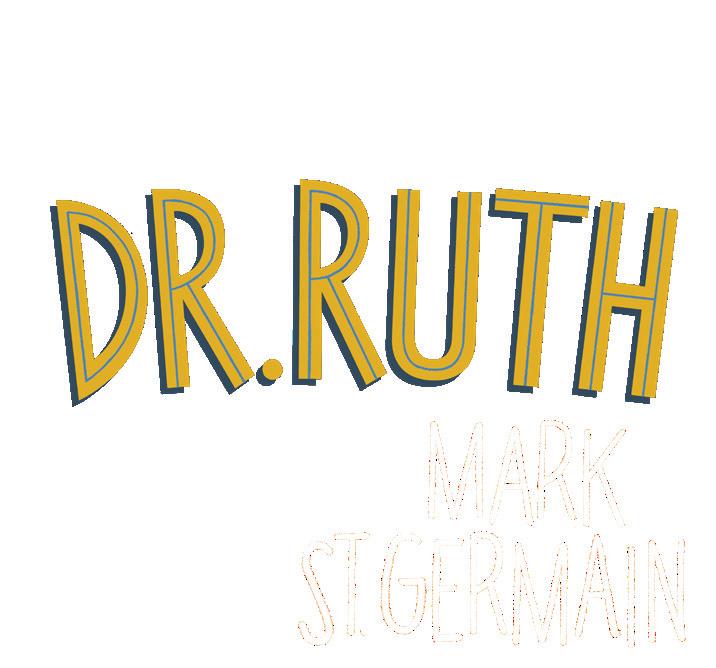


BUY YOUR TICKETS TODAY!
Boys will land at The Anthem (April 7) and Strathmore will welcome Tony Bennett (March 15) and Lea Salonga (April 17).
DANCE
This spring, The Washington Ballet will dance “Swan Lake” in the Kennedy Center Eisenhower Theater to live performances of Tchaikovsky’s classic score by the Washington Ballet Orchestra. Additional staging and choreography by Artistic Director Julie Kent and Associate Artistic Director Victor Barbee will meld with the original choreography by Marius Petipa and Lev Ivanov (April 9 to 19).
Spring performances by Bowen McCauley Dance in the Kennedy Center Terrace Theater will feature an expanded collaboration between choreographer Lucy Bowen McCauley and Turkish composer Erberk Eryilmaz (March 27 and 28).
Dana Tai Soon Burgess Dance Company will present “Reflections of Sargent,” exploring the works and life of painter John Singer Sargent, at the National Portrait Gallery (April 5 and 7; May 10).
Anchors Aweigh! Diane Coburn Bruning’s Chamber Dance Project will hold its 2020 gala on two yachts anchored at the Capital Yacht Club at the Wharf (March 29). The company’s “New Works 2020” program, including four world premieres, will be presented in the Michael R. Klein Theatre (June 18 to 27).
A beautiful new drama about modern love THROUGH MARCH 15


America’s favorite sex therapist returns! MARCH 27 – APRIL 19

Dining Guide
WASHINGTON DC’S FINEST RESTAURANTS

THE OCEANAIRE SEAFOOD ROOM 1201 F ST., NW 202–347–2277 | theoceanaire.com The Oceanaire blends a sophisticated atmosphere with simple, seasonal and regionally-inspired cuisine – the result is “the ultra-fresh seafood experience”. From our wines and cocktails to our seafood, steak and desserts, our commitment to sustainable and locally-sourced ingredients is apparent in everything we do. Reserve your table today for an extraordinary dining experience.
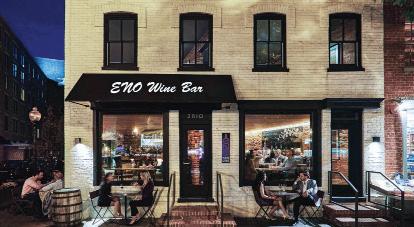
ENO WINE BAR 2810 PENNSYLVANIA AVE., NW 202–295–2826 | enowinerooms.com HAPPY HOUR: Offered nightly Tuesday - Thursday from 5 - 7 PM & Sunday from 4 - 7 PM. Enjoy select $7 wines on tap. Join us on Wednesday’s for College Nights from 9 - 11 PM and Sunday’s for 30% off bottles. Our delightful wines are best enjoyed with local charcuterie, cheese and small plates.
CAFE BONAPARTE 1522 WISCONSIN AVE., NW 202–333–8830 | cafebonaparte.com Captivating customers since 2003, Cafe Bonaparte has been dubbed the “quintessential” European café, featuring award-winning crepes and arguably the “best” coffee in D.C.! Other can't-miss attractions are the famous weekend brunch every Saturday and Sunday until 3 p.m. and our late-night weekend hours serving sweet and savory crepes until 1 a.m.


FILOMENA RISTORANTE 1063 WISCONSIN AVE., NW 202–338–8800 | filomena.com A Georgetown landmark for over 30 years featuring styles and recipes passed through generations. Balanced cuttingedge culinary creations of modern Italy using the fresh ingredients and made-from-scratch sauces and pastas. Seen on The Travel Channel, Award-winning Filomena is a favorite of U.S. Presidents, celebrities, sports legends, political leaders. “Don’t miss their bakery’s incredible desserts” - Best in D.C.
MARTIN’S TAVERN 1264 WISCONSIN AVE., NW 202-333-7370 | martinstavern.com Fifth generation Lauren Martin learns the family business from her dad, Billy Martin, Jr. Since 1933, the warm atmosphere of Martin’s Tavern has welcomed neighbors and travelers looking for great food, service and years of history within it’s walls. Fourth generation owner Billy Martin. Jr. continues the tradition of Washington’s oldest family-owned restaurant.
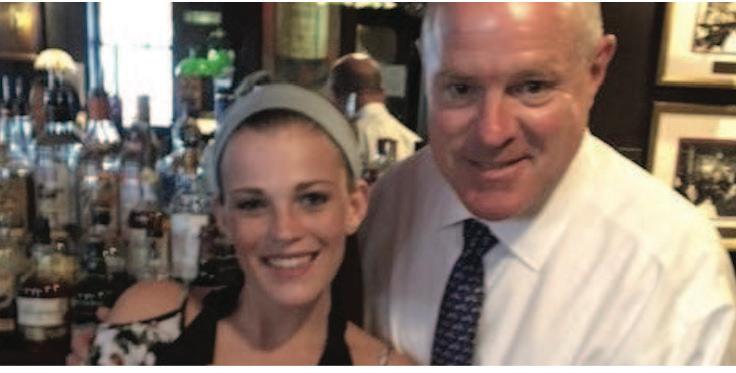

ROCKLANDS BARBEQUE 2418 WISCONSIN AVE., NW 202-333-2558 | rocklands.com This original location has served barbecue since 1990. We now have more space for you to sit down with family and friends at our new dining room Driving or walking up Wisconsin Avenue, you ask “mmmm, what’s that aroma??” That’s pork, beef and chicken coming out of our wood-only smoker, falling off the bone and ready for a dousing with our Original Barbeque Sauce.
JOIN THE DINING GUIDE!
EMAIL ADVERTISE@GEORGETOWNER.COM
OR CALL 202-338-4833
BY JODY KURASH
Pho, egg coffee and beer hoi — some of the most popular gastronomical delights sought out by visitors to Vietnam.
Pho, a fragrant, piquant noodle soup, is practically the national dish of Vietnam. Beer hoi refers to street-side stalls where tourist and locals alike hunker down on kindergarten-sized plastic stools and enjoy beers for as low as 5,000 dong (about 22 cents). Conversation flows as freely as the beer.
Egg coffee is a delicacy consisting of a white, meringue-like egg topping with robust Vietnamese coffee underneath. According to the Guardian, it was “invented in 1946 at Hanoi’s Sofitel Legend Metropole hotel. At the time, milk was scarce in Vietnam so whisked egg yolk was used as a replacement for café au lait and cappuccinotype drinks which were in demand by the French occupiers.”
Egg coffee remains a national pride to this day. The son of its inventor still makes it from the authentic recipe at his popular Giang café.
If you are looking for adult versions of Vietnamese cuisine, pho-inspired cocktails can be found in various bars in Hanoi, including the renowned one at the Unicorn Pub.
As for a loaded egg coffee, I was pleasantly surprised to find an interesting variation combining Vietnam’s love of beer and coffee in one glass.
The discovery came while visiting one of Hanoi’s most famous Instagram sites, Train Street, where, instead of pavement, a single train track runs through the narrow corridor. Passing diesels roar by, inches from homes and shops. Everyone packs up and ducks inside until they pass. The routine repeats throughout the day.
In between the locomotives’ scheduled arrivals, tourists pose for photos. An abundance of cafés serve drinks and food. So, when my Instagram-crazy friend Ben Whittaker came to visit, this was one of the first places I showed him. It was there that I noticed on a menu, along with a selection of local brews, an entry for egg beer that intrigued me.
Ben was given his bottled beer immediately, while I waited in anticipation. I heard the sound of beating eggs first, followed by an electric mixer. I watched the woman in the café diligently working

like a Christmas elf as her bowl filled with a frothy white substance and the smell of sugar cookies filled the air.
She carefully spooned the fluffy, cloudlike mixture into a big mug and placed it on my trackside table along with a Hanoibranded beer. I watched as she delicately poured the beer to top off the mug without destroying the billowy foam.
The result was a large floating island of meringue; the beer settled nicely on the bottom. It was so thick and fluffy, I needed a spoon to scoop a piece off the top.
The flavor of condensed milk and vanilla melted in my mouth. As I titled my glass to take a sip, some beer poured through the feather-like meringue to create a silky taste. The flavors were paradoxical — bitter, hoppy and fizzy followed sweet pastry dream — but together they mingled for a gleeful taste, akin to having a beer with your birthday cake.
I continued to enjoy my sweet and sharp treat until I was signaled by the owner to move off the patio. Seconds later, I heard a rumble, then felt a breeze passing through my hair as a train sped past me.
Without delay, the cafés began returning tables and chairs to their places and tourists started snapping shots of the last car riding off in the distance. Another typical day in Hanoi.
Making egg beer (or coffee) at home is not difficult, but requires a strong arm or an electric mixer.
Egg Beer Cocktail 1 egg yolk 1 oz. sweetened condensed milk Dash of vanilla extract 1 beer (your choice) Put the egg yolks, condensed milk and vanilla extract in a large mixing bowl. Whisk with electric beaters for at least 5 minutes or until pale and foamy. Spoon mixture into a large beer mug. Pour beer slowly while tilting the glass to avoid disturbing the egg foam.






